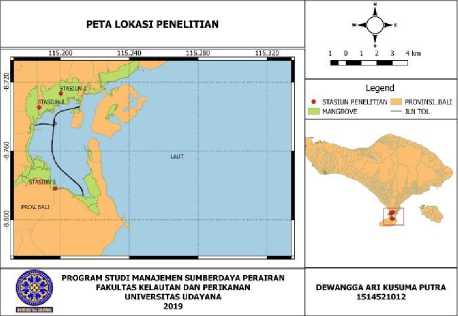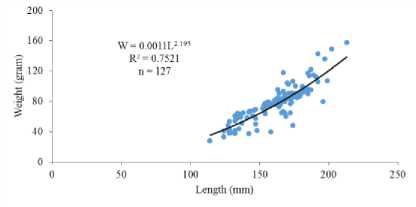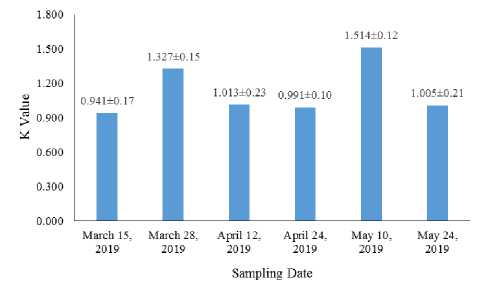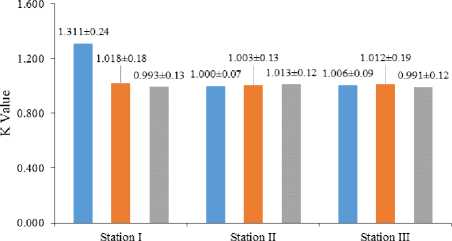Length-Weight Relationship and Condition Factors of Mullet Fish (Mugil cephalus) Caught at the Waters of Ngurah Rai Grand Forest Park, Bali
on
Advances in Tropical Biodiversity and Environmental Sciences 5(1): 12-16, February 2021 e-ISSN:2622-0628
DOI: 10.24843/ATBES.2021.v05.i01.p02 Available online at: https://ojs.unud.ac.id/index.php/ATBES/article/view/69328
12
Length-Weight Relationship and Condition Factors of Mullet Fish (Mugil cephalus) Caught at the Waters of Ngurah Rai Grand Forest Park, Bali
Dewangga Ari Kusuma Putra1*, I Wayan Restu1, and I Wayan Darya Kartika1
123Department of Aquatic Resources Management, Faculty of Marine and Fisheries, Udayana University Jl. Kampus Unud Bukit Jimbaran, Kuta Selatan, Badung, Bali
*Corresponding author: aridewangga22@gmail.com
Abstract. Grey Mullet fish (Mugil cephalus) is one of the economically valuable fish in the waters of the Ngurah Rai Forest Park, Bali. This study was conducted to examine the relationship between the length and weight of the condition of Belanak fish caught in the waters of the Ngurah Rai Forest Park, Bali. The purpose of this study was to determine the description of the growth conditions of Belanak in the waters of Ngurah Rai Tahura, Bali will create a plan for sustainable management of Belanak Fish resources. Sampling was conducted in March 2019 to May 2019. Data analysis used was the relationship between length and weight and condition factors. Data processing is done by using the Microsoft Excel program. The results obtained showed that the mullet fish has a negative allometric growth pattern (long growth is faster than weight growth) equation W = 0.011 L2.195 and the coefficient of determination (R2) of 0.75 (75% growth in weight is influenced by growth long). Belanak fish caught in Ngurah Rai Tahura waters have a condition factor value (K value) ranging from 0.941 to 1.514 which indicates that Belanak is in good condition and is in its infancy.
Keywords: grey mullet fish (Mugil cephalus); length and weight relationship; condition factor.
-
I. INTRODUCTION
The Ngurah Rai Grand Forest Park (TAHURA) area is one of the mangrove ecosystems in Bali, which is located in the City of Denpasar and Badung Regency. The existence of mangroves has an important role for aquatic fauna habitat as a habitat for spawning, nursery and feeding ground [1]. One of the fish that live in the waters of the Ngurah Rai Forest Park is the Belanak Fish. In general, these fish live in shallow waters, estuaries, and mangrove swamps with sandy mud substrates. Belanak fish are included in the Mugilidae group which migrate from brackish waters to sea water to spawn and their larvae are often found in coastal waters near river estuaries [2]. Mackerel is ecologically very important in the food chain, which plays a role in energy transfer in estuary waters [3]. Most of mullet fish production is still carried out by fishing in the waters. According to production data for mullet fishing by the Ministry of Marine Affairs and Fisheries of the Republic of Indonesia in 2018, production of mullet fishing in Indonesia in 2018 was 84,203 tons. Meanwhile, the production of mullet fish in Bali Province in 2018 was 50.2 tonnes [4]. Most of the fishing of mullet in Ngurah Rai Forest Park uses gill nets. The gill nets are installed when the water has not reached the peak of the highest tide, which aims to prevent the distance between the bottom of the water and the gill nets from being too wide so that the mullet fish that are on the bottom of the water can be
caught. The gill nets used have selectivity so that small fish are not caught, but there are also some fishermen who use gill nets with a small mesh size so that young fish are caught. If this is done continuously, it can cause degradation in the mullet fish population in the waters of Tahura Ngurah Rai. A fishing business activity in an area requires a comprehensive study, one of which is from a biological aspect [5]. Therefore, this study aims to provide an overview of the growing conditions of mullet fish in the waters of the Ngurah Rai Grand Forest Park so that a sustainable and sustainable mullet fish resource management plan will be created.
-
II. RESEARCH METHODS
Time and Location of the Research
This research was conducted for 3 months, namely in March - May 2019 in the waters of the Ngurah Rai Forest Park, Bali. Data collection was carried out at 3 stations, namely at the Estuary Water Gate of DAM Denpasar (Station I), Suwung Kauh Pemogan (Station II) and Taman Werdi Mumbul (Station III) (Figure 1).
Tools and Materials
The tools used in this research were camera phones, laptops, calipers, trays, digital scales (Shimadzu Corporation Japan, UX-4200 H). The material used in this research was mullet fish (Mugil cephalus).

Figure 1. Map of sampling locations
Fishes Sampling Method.
This research is a quantitative descriptive study with a sampling method based on simple random withdrawal of the fishermen's catch. Fish growth data was collected by collecting primary data on length and weight of mullet.Sampling was conducted every two weeks for 3 months. The mullet fish samples were obtained from the same fishermen at each sampling to ensure that the mullet fish came from the same location. Fish samples were put into containers and then labeled containing the station number, sample number, and date of sampling, then the fish samples were observed at the Fisheries Laboratory, Faculty of Marine Affairs and Fisheries, Udayana University.
Fish Measurement Method
The method of measuring fish is done by measuring the length and weight of the fish. Measurement of length and weight of fish samples was carried out at the Fisheries Laboratory, Faculty of Marine Affairs and Fisheries, Udayana University by measuring the length of fish samples using a caliper with an accuracy of 0.01 mm in order to minimize measurement bias. To measure the weight of fish using a digital scale with an accuracy of 1 gram.
Data analysis
Size Distribution
Determination of length frequency data is done by determining the number of class, range of date, and interval length.
K = 1+ 3,322 log N
R = Highest value – Lowest value
R
C1 = ∑K
Where K is the number of groups; N is the amount of data R is range of date; R is the data range; K is the number of groups; Ci is Interval length.
Length and weight
To analyze the length-weight relationship of each mullet fish species, the following formula is used [6]:
W = aLb
Where W is Weight; L is Length; a is the intercept (the intersection of the curve of the relation of Length of weight to the y axis); and b = Estimator of length-weight growth pattern. The length-weight relationship can be seen from the constant value b (as an estimate of the level of closeness of the relationship between the two parameters), namely the hypothesis:
-
1. H0: b = 3, the relation of length with weight is isometric.
-
2. H1: b ≠ 3, the length-weight relationship is allometric, there are two kinds of allometric growth patterns, namely:
-
A. Allometric is positive, if b> 3 the weight gain is faster than the length gain.
-
B. Allometric is negative, if b <3, the increase in length is faster than the weight gain.
Condition Factor
Condition factors indicate physical conditions for survival and events [6].
W κ~aLb
Where K is the condition factor; W is the weight of the fish (grams); L is length (mm); a is an intercept (the intersection of the curve for the relation of length and weight to the y-axis); and b is estimator of growth pattern in length and weight.
-
III. RESULT AND DISCUSSION
Size Distribution
Size distribution data is obtained from the length of the mullet which is then plotted in a graph to see the long frequency mode shift. The mullets obtained during the study were 127 with 40 fish in March, 43 in April and 44 in May. The minimum and maximum length of the mullet ranges from 114 mm to 213 mm. Based on the frequency distribution graph, it is found that there is a mode shift to the right every month. Graph of frequency distribution of mullet caught in Tahura by month is presented in Figure 2.
The shift in the length frequency mode from March to May moves to the right, which indicates the growth of mullet fish. This is indicated by an increase in the mode every month. This mode shift can be caused by several factors such as differences in fishing gear used in fishing in the two locations. The fishing gear used in the research is an important factor because the high gear selectivity causes the fish caught to have a nearly uniform size while the low gear selectivity results in a more diverse catch size [7]. In addition, different fishing ground can also affect this mode shift [8].

Figure 2. Size Distribution of mullets fish
Length and weight
There were 127 mullets caught during the study. The catch includes 58 individuals at station I, 76 at station II, and 22 at station III. The mullet (Mugil cephalus) at station I has a body length range of 114 - 213 mm and a body weight range of 28.10 - 157.96 grams. The average body length of mullet fish at station I is 155, 57 mm and the average body weight is 72.08 grams. At Station II, Belanak Fish has a body length range of 127 - 202 mm and a body weight range of 47.98 - 148.92 grams. The average body length of mullet fish at station II was 167.87 mm and the average body weight was 84.76 grams. Whereas at station III, mullet fish has a body length range of 132 - 199 mm and a body weight range of 53.73-107.22 grams. The mullet at station III has an average body length of 164.95 mm and an average body weight of 79.06 grams.

Figure 3. The graph of the length and weight relationship mullet fish at all stations
Figure 3 shows that the length-weight relationship of mullet fish at all stations is obtained by the equation W = 0.0011L2.195. The a value obtained is 0.0011 and the b value is 2.195 then ttest (α = 95%) is carried out on the b value, the t value (7.142) > ttable (2.268) and the b value < 3. The value of b < 3 showed that mullet fish at all stations had a negative allometric growth pattern, which means that the body length gain is faster than the body weight gain.
Based on the results of the analysis of the length-weight relationship of mullet caught in the waters of Tahura Ngurah Rai, the equation W = 0.0011L2.195 is obtained. The coefficient of determination (R2) is 75%, which indicates that 75% of weight growth is influenced by the growth of mullet fish body length and the remaining 25% is influenced by other factors. The b value obtained is 2.195 and after the t test (α = 0.05) is carried out on the b value it is known that the mullet fish in the waters of Tahura Ngurah Rai has a negative allometric growth pattern, namely the length growth is greater than the weight growth. The length-weight relationship is negative allometric if the value of b < 3 [6].
In the results of research at a different location, namely in the mouth of the Nigerian Brass river, mullet (Mugil cephalus) has a negative allometric growth pattern with a b value of 1.743 and a coefficient of determination (R2) of 0.85 which indicates that 85% of weight growth is influenced by growth length [9]. Research in Sungai Matang Guru, East Aceh also shows a negative allometric growth pattern with a b value of 2.03 and a determination coefficient of 0.98 which indicates that 98% of weight growth is influenced by the growth of mullet [10]. The research on mullet fish (Mugil cephalus) in Banten Bay which showed a negative allometric growth pattern with a b value of 0.79 (R2 = 0.23) and 1.41 (R2 = 0.16) [8]. According to its nature as an active swimming fish, it can be said to have a negative allometric growth pattern. Research The growth patterns of various studies show different results for several waters. The difference in b value from several studies according to Jennings et al (2001) is influenced by the physiological conditions of fish and the environment such as temperature, pH, salinity, geographic location and sampling techniques [11]. In addition, the biological conditions of fish such as gonad development and food availability also affect the value of b [12].
Condition Factor
The condition factor is the condition of the fish which is expressed in numerical form based on the length and weight data [6]. The condition factor can also describe a water condition through the calculation results of the fish in the water area. The average value of the mullet fish condition factor as a whole for the highest was found in the fifth data collection (May 10, 2019) of 1.514 and the lowest average condition factor value was found in the first data collection (March 15, 2019) of 0.941 because in early March there was relatively high rain, causing a decrease in the level of food availability in the waters of Tahura Ngurah Rai which had an impact on the growth of mullet fish. The graph of the average condition factor value for mullet is shown in Figure 4.

Figure 4. Average value of mullet fish condition factors at each sampling.
Based on the sampling station, the average value of the mullet shows a graph that tends to decrease at each station. The average condition factor for each station is shown in Figure 5.

■ March ■ April ■ May
Figure 5. Comparison of the average value of the mackerel condition factors based on the sampling station.
Figure 5.shows the difference in the average value of the mackerel condition factors in each month at each station. The mullet in April showed the average value of the condition factor which was lower than the average value of the mackerel condition factor in March and May. The average value of the highest condition factor for mullet fish at Station I was 1.311; at Station II it was 1.013 and at Station III was 1.012.
Based on the results of the research, the condition factors of mullet fish (Mugil cephalus) caught in the waters of Tahura Ngurah Rai obtained an average value ranging from 0.941 to 1.514 (Figure 5). The average value of the mackerel condition factor varies at each data collection. The results showed that there was a difference in the K value in data collection I on March 15, 2019, which had the lowest value of 0.941. This is presumably because in early March there was relatively high rain, causing a decrease in the level of food availability in the waters of Tahura Ngurah Rai which had an impact on the growth of mullet fish. Medeiros & Arthington stated that the composition of fish food is strongly influenced by differences in season and location [13]. The highest condition factor was in data collection on May 10, 2019,
amounting to 1.514. In this study it can be said that the K value of 0.9 is close to the value of 1 and it can be assumed that it is in good condition and has a thin body shape. The condition factor value shown proves that the mullet fish physiology is in good condition and has a body that is less flattened or thin. This indicates a close relationship with a negative allometric length-weight relationship where long growth is faster than weight growth, so it can be said that the mullet caught in the waters of the Ngurah Rai Grand Forest Park has a thin body According to Effendie (1997) which states that K values ranging from 1-3 indicate a good condition and have a thin body [6].
The results of the research the K value of each station is in the range 0.993-1.311. The lowest K value in station I is 0.993 which is close to the value of 1 so it can be assumed that the mullet is in a thin condition. The value of K is above 1 which indicates that the waters of Tahura Ngurah Rai provide enough food. This is consistent with the statement of Mulfizar et al. (2012) which states that the value of the condition factor above 1 indicates that these waters provide adequate nutrition and food [14].
The Ngurah Rai Tahura area has a mangrove area with an ecological function as a food source for fish, namely in the form of organic material formed from falling leaves. The high level of organic matter in the mangrove area makes the area a food supplier and a place to care for various biota such as fish, shrimp and crabs [1]. Mangrove areas are rich in nutrients as food (feeding ground) for juvenile mullet so that the environmental conditions are more favorable for fish growth [15].
-
V. CONCLUSION
Based on the results obtained in this study, the following conclusions can be drawn: The mullet caught in the waters of Tahura Ngurah Rai has a negative allometric growth pattern where the growth of fish body length is faster than the growth of fish body weight with the equation W = 0.011L2.195 and the coefficient of
determination (R2) of 0.75 (75% of weight growth is influenced by length growth). The mullet caught in the waters of Tahura Ngurah Rai has a condition factor value (K value) ranging from 0.941-1.514 which indicates that the mullet is in good condition and is in its infancy. Besides that, the value of the condition factor also indicates that the mullet has a lean body morphology which is thought to be due to disease infection, fighting over food and fighting for space and place.
REFERENCES
-
[1] Buwono, YR. 2015. Potential of Aquatic Fauna in Mangrove Forest Ecosystem in the Pangpang Bay Area, Banyuwangi. [Thesis]. Environmental Science
Master Study Program. Udayana University.
Denpasar. 103 page.
-
[2] Blaber, SJM. 1997. Fish and Fisheries of Tropical Estuaries. Australia. Chapman and Hall. 206 P.
-
[3] Ramli, M. 2012. Contribution of Mangrove Ecosystems as Food Suppliers for Belanak Fish (Liza subviridis) in the North Coast of South Konawe. Southeast Sulawesi. [Disertasi]. Bogor: Master Program, IPB University.
-
[4] Directorate General of Capture Fisheries, 2018. Indonesian Capture Fisheries Statistics. Ministry of Marine Affairs and Fisheries Republic of Indonesia.
-
[5] Frastia, R. 2017. Relationship of Length-weight and Condition Factors of Mullet (Liza subviridis) Landed at the Fish Landing Site in Pangpang Bay, Banyuwangi, East Java. [Essay]. Surabaya. Faculty of Fisheries and Marine, Airlangga University.
-
[6] Effendie, H. M. I. 1997. Fisheries Biology. Pustaka Nusatama Foundation. Yogyakarta. 163 p.
-
[7] Sulistiono, Muhamad Arwani, & K.A. Aziz. 2017. Growth of Mullet Fish (Mugil dussumieri) in Ujung Pangkah Waters, East Java. Indonesian Journal of Iktiology. Vol. 1 (2): 39-47.
-
[8] Nuringtyas, A. E. 2019. Biological Aspects of Mullet Fish (Mugil cephalus) in the Bay of Banten.
Jalanidhitah Sarva Jivitam Bulletin 1 (2): 81-77
-
[9] Seiyaboh, E.I., Harry, G. A., Izah, S. C. 2016. LengthWeight Relationship and Condition Factor of Five Species from River Brass, Niger Delta. Biotechnological Research. Vol. 2 (4): 187-192
-
[10] Muttaqin, Zainal., Dewiyanti, Irma., Aliza, Dwinna. 2016. Study of the Relationship of Length-Weight and Condition Factors of Tilapia (Oreochromis niloticus) and Mullet Fish (Mugil cephalus) Caught in the Matang Guru River, Madat District, East Aceh Regency. Faculty of Veterinary Medicine. Syiah Kuala University. Banda Aceh.
-
[11] Jenning, S., Pinnegar, J.K., Polunin, N.V.C. & Warr, K.J. (2001) Impacts of Trawling Disturbance on The Trophic Structure of Benthic Invertebrate Communities. Marine Ecology Progress Series, in press.
-
[12] Froese, R. 2006. Cube Law, Condition Factor and Weight–Length Relationships: History,MetaAnalysis and Recommendations. J. Appl. Ichthyol., 22: 241– 253.
-
[13] Medeiros, E. S. F., Arthington, A. H., 2008. The Importance of Zooplankton in The Diets of Three Native Fish Species in Floodplain Waterholes of a Dryland River, The Macintyre River, Australia. Hydrobiologia, 614: 19-31.
-
[14] Mulfizar, M., ZA Muchlisin, I Dewiyanti. 2012. The relationship of length-weight and the factor of three types of fish caught in the waters of Kuala Gigieng, Aceh Besar, Aceh Province. Depik, 1(1): 1-9.
-
[15] Wahyudewantoro, G., Haryono. 2013. Relationship of Length-weight and Condition Factors of Mullet (Liza subviridis) in Ujung Kulon National Park, Pandeglang, Banten. Bionatura Journal of Life and Physical Sciences. 15(3): 175-178.
Discussion and feedback